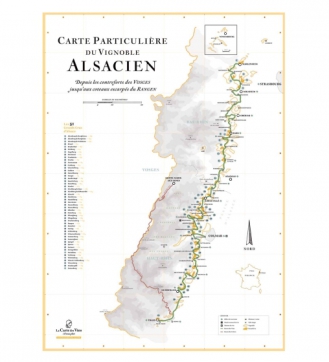Alsace
Located in the villages of Beblenheim, Riquewihr, Ostheim, Zellenberg and Mittelwihr, between 200 and 280m above sea level, our vineyard has a Continental climate with cold and freezing winters which contrast with hot and sunny summers and autumns.
It benefits from a very favorable microclimate with little precipitation (just over 500mm per year). It extends over a clay-limestone and marno-schistous stratified soil dating from the
Eocene-Oligocene era. In addition, it is made up of a conglomerate with a tertiary border on the Rhine.
The whole of the vine is exploited in reasoned culture. This means that it opts for sustainable and environment-friendly agriculture with rationalized phytosanitary protection of the vine throughout
the production process, from the vineyard to bottling.
Meyblum & Fils
Cuvée Tradition
Our Alsace Tradition range comes from plots located in the plain. The latter benefit from a rich terroir promoting the purest expression of the grape variety. The vines grow there without constraint. The wines present profiles mixing typicity with a character both supple and resolutely dynamic.
Cuvée Prestige
Our Alsace Prestige proudly represent our most beautiful plots located on hillsides and mainly from old vines. These last benefit from an optimal sunning on a draining soil and the harvests are carried out manually. These wines harvested at maturity have a structured, intense and mineral character.
Varietal: Edelzwicker, Pinot Blanc, Riesling, Pinot Gris, Gewürztraminer, Pinot noir
Crémants d'Alsace
Crémant d'Alsace is a sparkling wine made in the traditional method with a blend of Pinot Auxerrois and Pinot Blanc as the main grape varieties for white, and Pinot Noir for Rosé. The grapes used for the Crémant are harvested by hand at the start of the day during the harvest in September. For these Brut Symphonique cuvées, we are looking for the perfect balance between sweetness and natural acidity in order to suit all tasting occasions and to please all palate.
According to the strict production rules written in the 1976 decree, the grapes picked by hand must be transported in containers with a capacity of less than 100 kg so that the grapes remain intact during the pressing. After the traditional fermentation (not malolactic), it is in the bottle, that a second fermentation takes place thanks to the liqueur of draw, a proportioned mixture of yeasts and sugar. And it is at this point that the foam begins to form, making the wine sparkling. This is followed by 12 months of aging on the lees, where the bottles are subjected to a daily rotation (from horizontal to vertical position), so that the yeast deposit accumulates in the neck of the bottle. Then, the neck of the bottle is frozen and the sediment is ejected by natural pressure, the remaining space is filled with concentrated grape must to make the final dosage of sugar, this dosage is called expedition liqueur.
Download Zone
ALSACE MEYBLUM
English Version
Alsace Techinical Sheets - EN.pdf
Document Adobe Acrobat [811.6 KB]






